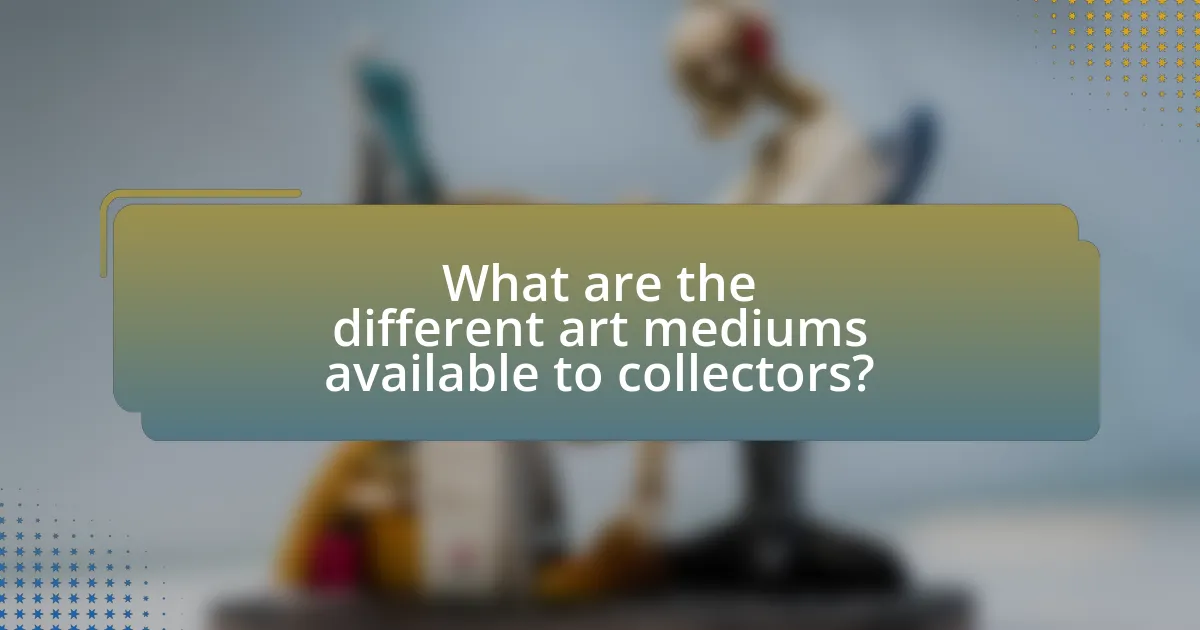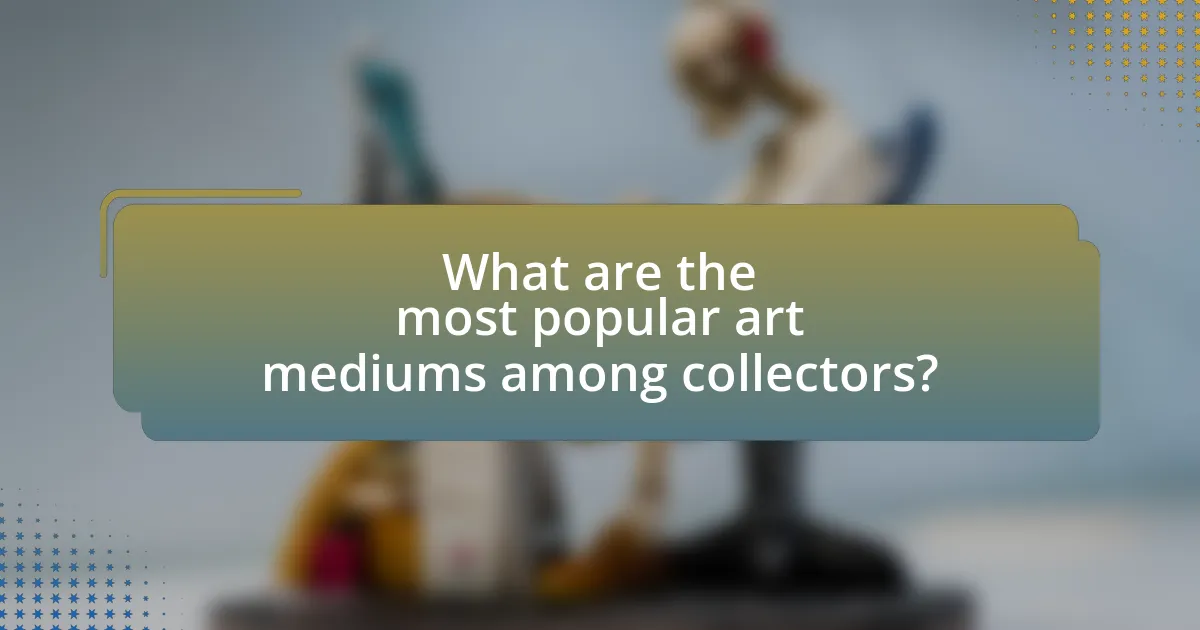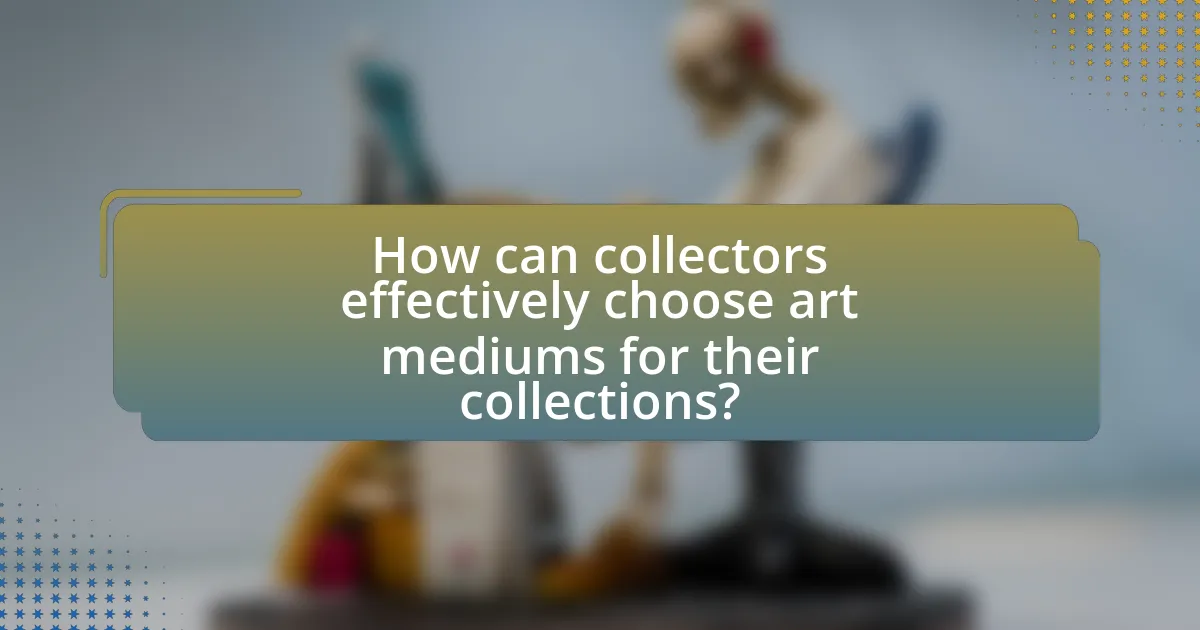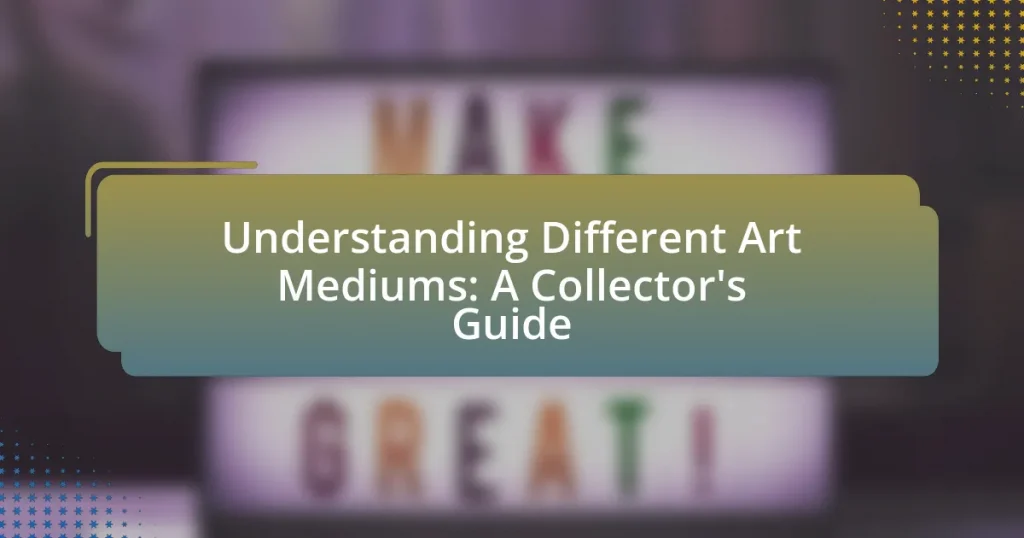The article “Understanding Different Art Mediums: A Collector’s Guide” provides a comprehensive overview of various art mediums available to collectors, including painting, sculpture, photography, printmaking, ceramics, textiles, and digital art. It distinguishes between traditional and contemporary mediums, highlighting their unique characteristics, techniques, and historical significance. The article emphasizes the importance of understanding these mediums for informed collecting decisions, discussing factors such as market trends, personal taste, and the impact of medium choice on artwork value and longevity. Additionally, it offers best practices for collectors to educate themselves about different mediums and make informed choices in their art acquisitions.

What are the different art mediums available to collectors?
Collectors have access to various art mediums, including painting, sculpture, photography, printmaking, ceramics, textiles, and digital art. Each medium offers unique characteristics and aesthetic qualities that appeal to different tastes and preferences. For instance, painting encompasses oil, acrylic, and watercolor techniques, while sculpture can be made from materials like bronze, marble, or wood. Photography has evolved with technology, allowing for both traditional and digital formats. Printmaking includes techniques such as lithography and etching, while ceramics and textiles showcase craftsmanship in functional and decorative forms. Digital art has gained prominence with the rise of technology, allowing for innovative expressions. Collectors often choose mediums based on personal interest, investment potential, and the historical significance of the works.
How do traditional mediums differ from contemporary ones?
Traditional mediums, such as oil painting, watercolor, and sculpture, differ from contemporary mediums, which include digital art, installation, and mixed media, primarily in their materials and techniques. Traditional mediums rely on established techniques and physical materials that have been used for centuries, emphasizing craftsmanship and the artist’s hand. In contrast, contemporary mediums often incorporate technology and innovative practices, allowing for a broader range of expression and interaction with the audience. For example, digital art utilizes software and hardware to create works that can be easily reproduced and shared, reflecting the digital age’s influence on art. This distinction highlights the evolution of artistic expression and the impact of cultural shifts on the creation and perception of art.
What defines traditional art mediums?
Traditional art mediums are defined by their use of physical materials and techniques that have been historically established in the art world. These mediums include oil paint, watercolor, acrylic, charcoal, graphite, ink, and clay, among others. Each medium has specific properties and methods of application that influence the final artwork, such as the texture, color, and durability. For instance, oil paint allows for rich color blending and a slow drying time, enabling detailed work, while watercolor is known for its transparency and fluidity. The historical significance of these mediums is evidenced by their use in classical art movements, such as the Renaissance and Baroque periods, where artists like Leonardo da Vinci and Rembrandt utilized these materials to create enduring masterpieces.
What are the characteristics of contemporary art mediums?
Contemporary art mediums are characterized by their diversity, innovation, and integration of technology. These mediums often include traditional forms such as painting and sculpture, alongside newer forms like digital art, installation, and performance art. The use of mixed media is prevalent, allowing artists to combine various materials and techniques to create unique expressions. Additionally, contemporary art mediums frequently engage with social and political themes, reflecting current issues and cultural dialogues. This adaptability and responsiveness to the contemporary context make these mediums dynamic and relevant in today’s art world.
Why is it important to understand various art mediums?
Understanding various art mediums is important because it enhances appreciation and informs decision-making in art collection. Different mediums, such as painting, sculpture, and digital art, each have unique characteristics that affect their aesthetic, durability, and value. For instance, oil paintings typically offer rich colors and depth, while acrylics dry quickly and allow for different techniques. Knowledge of these differences enables collectors to select pieces that align with their preferences and investment goals. Furthermore, understanding mediums can also provide insight into an artist’s intent and the historical context of the artwork, enriching the overall experience of art appreciation.
How does knowledge of art mediums influence collecting decisions?
Knowledge of art mediums significantly influences collecting decisions by enabling collectors to make informed choices about the types of artworks they acquire. Understanding the characteristics, durability, and maintenance requirements of various mediums—such as oil, acrylic, watercolor, or mixed media—allows collectors to assess the long-term value and care needed for their collections. For instance, oil paintings typically require specific environmental conditions to preserve their quality, while watercolors may be more susceptible to fading. This knowledge helps collectors avoid potential pitfalls, such as purchasing works that may deteriorate over time or require costly restoration. Additionally, familiarity with art mediums can guide collectors in identifying trends and appreciating the unique qualities of different artworks, ultimately enhancing their overall collecting experience.
What role do art mediums play in the value of a piece?
Art mediums significantly influence the value of a piece by affecting its market demand, uniqueness, and the artist’s intent. Different mediums, such as oil, acrylic, watercolor, or mixed media, can evoke varying emotional responses and aesthetic qualities, which in turn impact collectors’ perceptions and willingness to pay. For instance, oil paintings often command higher prices due to their historical significance and durability, while contemporary mixed media works may attract collectors for their innovative approaches. Additionally, the medium can determine the rarity of a piece; for example, limited edition prints may hold less value compared to one-of-a-kind sculptures. Thus, the choice of medium plays a crucial role in establishing both the intrinsic and extrinsic value of an artwork.

What are the most popular art mediums among collectors?
The most popular art mediums among collectors include painting, sculpture, photography, and mixed media. Paintings, particularly oil and acrylic, dominate the market due to their historical significance and investment potential, with the global art market for paintings valued at approximately $65 billion in 2021. Sculpture is also highly sought after, with collectors valuing both contemporary and classical works, as evidenced by auction sales that often reach millions. Photography has gained traction as a collectible medium, with limited edition prints fetching high prices, reflecting a growing appreciation for the medium. Mixed media art, which combines various materials and techniques, appeals to collectors for its innovative and unique qualities, contributing to its rising popularity.
What are the key features of painting as an art medium?
The key features of painting as an art medium include the use of color, texture, and composition to convey emotions and ideas. Color allows artists to express mood and atmosphere, while texture adds depth and interest to the surface. Composition refers to the arrangement of elements within the artwork, guiding the viewer’s eye and enhancing the overall impact. Historically, painting has evolved through various styles and techniques, such as oil, watercolor, and acrylic, each offering unique properties that influence the final outcome. For instance, oil paint dries slowly, allowing for blending and layering, while acrylics dry quickly, enabling rapid application and experimentation. These features make painting a versatile and expressive medium in the art world.
What types of paint are commonly used in artworks?
Commonly used types of paint in artworks include oil paint, acrylic paint, watercolor, gouache, and tempera. Oil paint, known for its rich colors and versatility, has been used since the 15th century and allows for detailed blending and layering. Acrylic paint, developed in the mid-20th century, dries quickly and is water-soluble, making it popular for contemporary artists. Watercolor, characterized by its transparency and fluidity, is often used for landscapes and illustrations. Gouache, similar to watercolor but more opaque, is favored for its vibrant colors and matte finish. Tempera, a traditional medium made from pigments mixed with a water-soluble binder, has been used since ancient times, particularly in religious art. Each type of paint offers unique properties that influence the artist’s technique and the final appearance of the artwork.
How does the choice of paint affect the artwork’s longevity?
The choice of paint significantly affects an artwork’s longevity by determining its resistance to environmental factors and degradation over time. For instance, oil paints, known for their durability and flexibility, can last for centuries if properly maintained, while watercolors may fade and deteriorate more quickly due to their solubility and sensitivity to moisture. Additionally, the use of high-quality pigments and binders in acrylic paints can enhance their lightfastness, making them less prone to fading compared to lower-quality alternatives. Historical evidence shows that artworks created with professional-grade materials, such as those used by renowned artists, tend to retain their vibrancy and structural integrity longer than those made with inferior products.
What makes sculpture a unique art medium?
Sculpture is a unique art medium because it involves the creation of three-dimensional forms that occupy physical space, allowing for interaction from multiple viewpoints. Unlike two-dimensional art forms, such as painting or drawing, sculpture engages the viewer’s spatial awareness and can evoke a tactile response. This medium encompasses various techniques, including carving, modeling, and casting, which contribute to its diversity. Historically, sculptures have played significant roles in cultural expression, from ancient civilizations’ monumental works to contemporary installations, demonstrating their enduring relevance and adaptability in the art world.
What materials are typically used in sculpture creation?
Sculpture creation typically involves materials such as stone, metal, wood, clay, and plaster. Stone, including marble and granite, has been used since ancient times for its durability and aesthetic qualities. Metal, particularly bronze and steel, allows for intricate designs and longevity, as seen in many classical and contemporary works. Wood is favored for its versatility and warmth, while clay is often used for modeling and casting due to its malleability. Plaster serves as a medium for creating molds and preliminary models. These materials have been historically significant in various cultures, demonstrating their importance in the art of sculpture.
How does the medium impact the perception of a sculpture?
The medium significantly impacts the perception of a sculpture by influencing its texture, form, and emotional resonance. For instance, a marble sculpture conveys a sense of permanence and classical beauty due to its smooth finish and weight, while a bronze sculpture may evoke a sense of warmth and dynamism through its patina and ability to capture intricate details. Additionally, the choice of medium can affect the viewer’s interpretation; for example, contemporary materials like plastic or found objects may challenge traditional notions of art, prompting discussions about value and meaning. Historical context also plays a role; sculptures made from materials like wood or stone often reflect cultural significance and craftsmanship, shaping how audiences engage with the work.

How can collectors effectively choose art mediums for their collections?
Collectors can effectively choose art mediums for their collections by assessing their personal preferences, understanding the characteristics of various mediums, and considering the market trends. Personal preferences guide collectors toward mediums that resonate with their aesthetic values, while knowledge of mediums—such as oil, acrylic, watercolor, or mixed media—helps in appreciating the unique qualities and techniques involved. Additionally, staying informed about market trends, including the popularity and investment potential of specific mediums, enables collectors to make informed decisions that align with both passion and financial considerations. For instance, according to a report by Art Basel and UBS, contemporary art, particularly in mediums like digital and installation art, has seen significant growth in market value, indicating a shift in collector interest.
What factors should be considered when selecting an art medium?
When selecting an art medium, factors such as the desired effect, the artist’s skill level, the intended audience, and the longevity of the medium should be considered. The desired effect influences the choice; for instance, oil paints provide rich colors and textures, while watercolors offer transparency and fluidity. The artist’s skill level is crucial, as some mediums require more technical expertise than others, such as acrylics versus pastels. The intended audience can dictate the medium; for example, contemporary collectors may prefer mixed media, while traditionalists might favor oil or watercolor. Lastly, the longevity of the medium is important, as some materials, like charcoal, may fade over time, while others, like oil paints, can last for centuries if properly maintained.
How does personal taste influence medium selection?
Personal taste significantly influences medium selection by guiding individuals toward specific materials and techniques that resonate with their aesthetic preferences. For instance, a collector who appreciates vibrant colors may gravitate towards oil paintings, while someone who values texture might prefer mixed media or sculpture. This inclination is supported by studies indicating that emotional responses to art are closely tied to personal experiences and cultural backgrounds, which shape individual tastes. Therefore, the choice of medium often reflects a deeper connection to the artwork, aligning with the collector’s identity and values.
What is the significance of market trends in medium choice?
Market trends significantly influence medium choice by guiding collectors and artists toward popular and financially viable options. These trends reflect consumer preferences, which can shift based on cultural movements, economic conditions, and technological advancements. For instance, the rise of digital art has been driven by increased accessibility to technology and a growing market for NFTs, indicating a shift in medium preference among collectors. Understanding these trends allows stakeholders to make informed decisions, ensuring that their investments align with current market demands and potential future value.
What are some best practices for collecting art across different mediums?
Best practices for collecting art across different mediums include researching the artists and their backgrounds, understanding the specific characteristics of each medium, and considering the provenance and condition of the artwork. Researching artists provides insight into their techniques and market value, which is crucial for informed purchasing decisions. Understanding medium characteristics, such as the durability of oil paintings versus the fragility of glass sculptures, helps collectors make appropriate display and care choices. Additionally, verifying provenance ensures authenticity and can significantly affect an artwork’s value, while assessing condition is vital for long-term preservation. Collectors should also engage with art communities and attend exhibitions to gain exposure to diverse works and trends.
How can collectors educate themselves about various art mediums?
Collectors can educate themselves about various art mediums by engaging in structured learning through workshops, online courses, and art history books. Workshops often provide hands-on experience with different materials, while online courses from reputable institutions can offer in-depth knowledge about specific mediums, such as oil painting or sculpture. Additionally, reading art history books can provide context and understanding of the evolution and significance of various mediums in art. For instance, “The Story of Art” by E.H. Gombrich is a widely recognized resource that covers a range of mediums and their historical contexts, making it a valuable tool for collectors seeking to deepen their understanding.
What resources are available for understanding art mediums better?
Books, online courses, and art workshops are valuable resources for understanding art mediums better. Notable books include “The Artist’s Handbook of Materials and Techniques” by Ralph Mayer, which provides comprehensive insights into various mediums and their applications. Online platforms like Coursera and Skillshare offer courses specifically focused on different art mediums, allowing learners to engage with expert instructors. Additionally, local art workshops often provide hands-on experience with various materials, enhancing practical understanding. These resources collectively support a deeper comprehension of art mediums through both theoretical knowledge and practical application.















